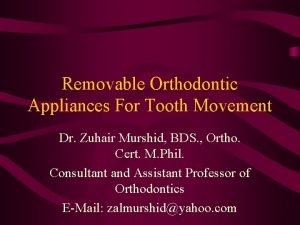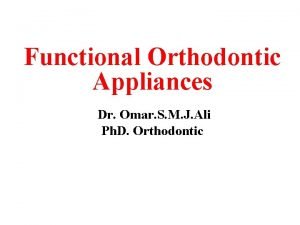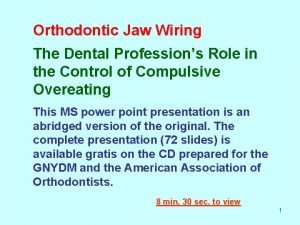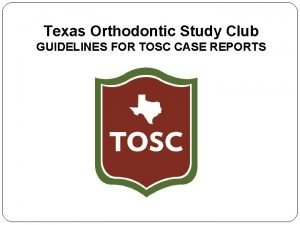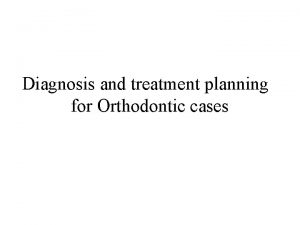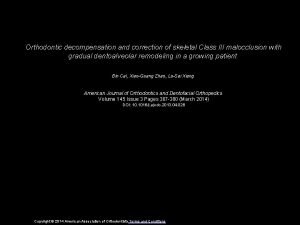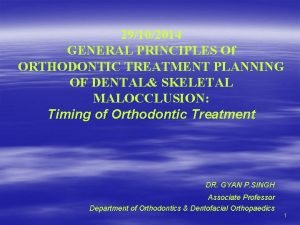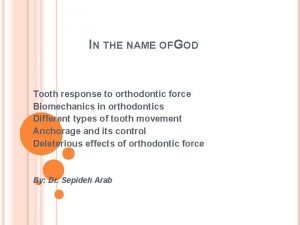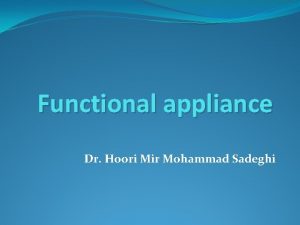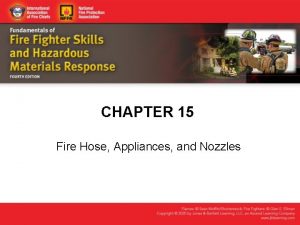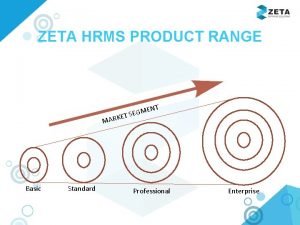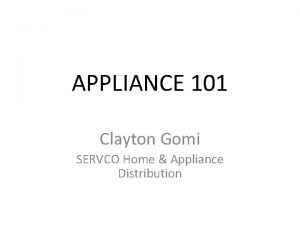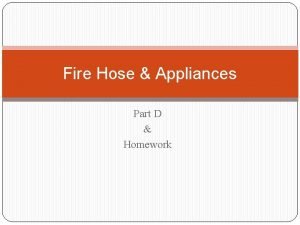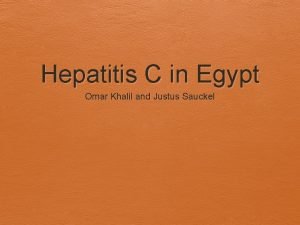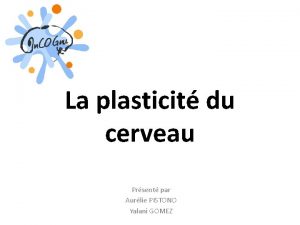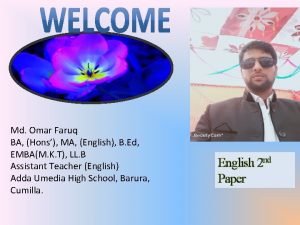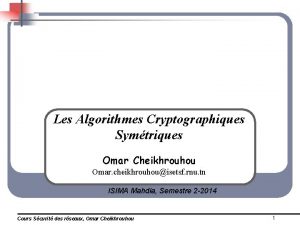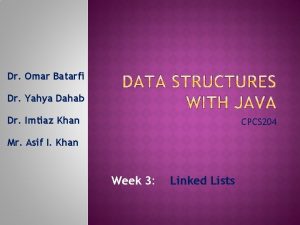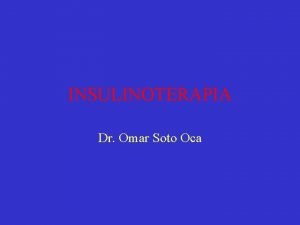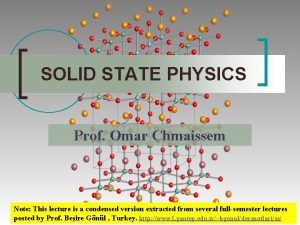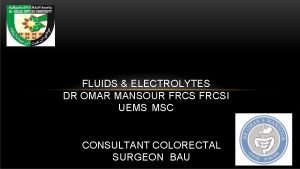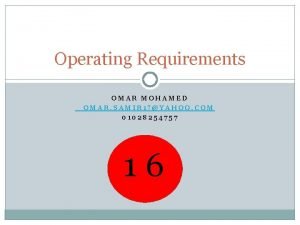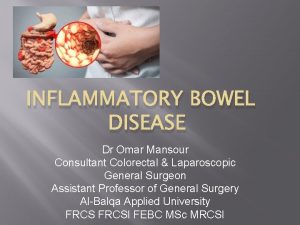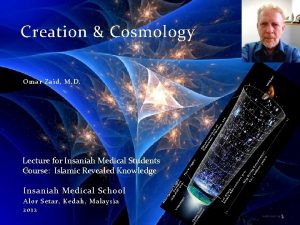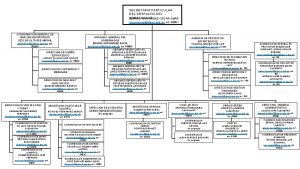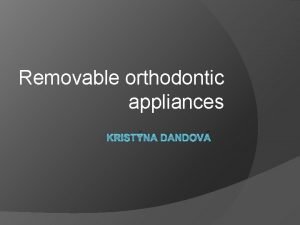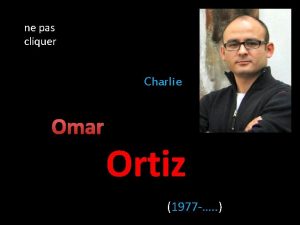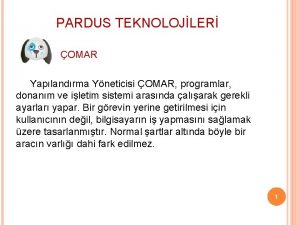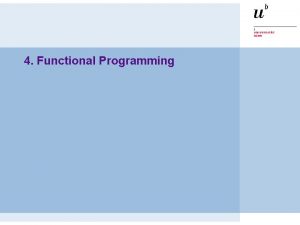Functional Orthodontic Appliances Dr Omar S M J














































































- Slides: 78

Functional Orthodontic Appliances Dr. Omar. S. M. J. Ali Ph. D. Orthodontic

Conventional orthodontic appliances use mechanical force to alter the position of tooth/ teeth into a more favorable position. However, the scope of these fixed appliances is greatly limited by certain morphological conditions which are caused due to alteration in the developmental process or the neuromuscular capsule surrounding the orofacial skeleton. To over come this limitation, functional appliances came into being.


These appliances are considered to be primarily orthopedic tools to influence the facial skeleton of the growing child. The uniqueness of these appliances lies in the fact that instead of applying active forces, they transmit, eliminate and guide the natural forces (e. g. muscle activity, growth, tooth eruption) to eliminate the morphological aberrations and try to create conditions for the harmonious development of the stomatognathic system. Most of the functional appliances are intraoral devices, and nearly all of them are tooth borne or supported by teeth.

With a few exceptions, these appliances are removable, consisting primarily of acrylic with wire components for retention and support. Most of the functional appliances are used to correct early Class II malocclusions and some cases of Class III malocclusion. About 40 %of all malocclusions treated belong to the Class II category

CLASSIFICATION OF FUNCTIONAL APPLIANCES Myofunctional appliances are classified into: I. Classification put (Tom Graber) when functional appliances were removable: 1. Group A-Teeth supported appliances, e. g. catlans appliance. 2. Group B-Teeth/tissue supported, e. g. activator, bionator, etc. 3. Group C-Vestibular positioned appliances with isolated support from tooth/tissue, e. g. Frankel appliance, lip bumpers.


II. With advent of fixed functional appliances, a new classification evolved: 1. Removable functionals, e. g. activator, bionator, frankel, etc. 2. Semi-fixed functional appliances, e. g. Den Holtz, Bass appliances, etc. 3. Fixed functional appliances, e. g. Herbst, Jasper jumper,

Classification (Profitt) 1. Teeth borne passive appliances-myotonic appliances, e. g. activator, 2. Tooth borne active appliances myodynamic appliances, e. g. elastic open activator (EOA) etc. 3. Tissue borne passive appliance, e. g. oral screen, lip bumpers, etc. 4. Tissue borne active appliances, e. g. Frankel appliances. 5. Functional orthopedic magnetic appliances (FOMA)

• Timing of Treatment • Effective during active growth effective growth • The faster the growth, the faster the response, the shorter the treatment time. • Most common time for treatment growth spurt. • Early treatment- 9 -10 yrs. • Definitive treatment- 12 -13 yrs.

Early Treatment • To intercept a developing problem to Improve aesthetics • Decreased trauma risk to anterior teeth • Early correction of habit • Improve eventual prognosis • Decrease length of definitive Treatment

Definitive Treatment ü During growth usually all permanent teeth have erupted. ü Correction max-mand discrepancy. ü Usually followed by fixed appliance Treatment ü Functional appliance may also be used during fixed appliance treatment

Effects of Treatment Skeletal Condylar growth Increased condylar remodel Increased glenoid fossa remodeling Increased lower face height Dental • Retroclination of upper incisors • Proclination of lower incisors • Mesial eruption of lower posterior teeth

Mode of Action of Functional Appliances • Dentoalveolar changes • Restriction of forward growth of maxilla • Stimulation of mandibular growth beyond growth what is normally seen in growing children • Redirection of condylar growth from upward growth and forward directed growth to posterior direction

• Changes in neuromuscular anatomy and function that would induce bone remodelling • Adaptive changes to glenoid fossa location to a more anterior and vertical location direction

Dento-Alveolar Effects • Dento-alveolar changes 60 -70%. • Inhibition of downward and forward eruption of maxillary teeth. • Retroclination upper incisors. • Proclination of lower incisors.

Orthopaedic Effects • Orthopaedic changes 30 -40% • Condylar growth Increased condylar remodelling • Increased glenoid fossa remodelling • Increased lower facial height




INDICATIONS • Actively growing individual with favorable growth pattern are good for the activator therapy. • Various types of activators have been devised for the treatment of various conditions like: • Class II division 1 malocclusion • Class II division 2 malocclusion • Class III malocclusion • Class I open bite malocclusion • Class I deep bite malocclusion • For post-treatment retention • Children with decreased facial height

CONTRAINDICATIONS ü Cannot be used in correction of Class I problems of crowded teeth where there is disharmony between tooth size and jaw size cannot be used in children with excess lower facial height. ü Cannot be given in cases with lower proclination ü In case of nasal stenosis. ü In non-growing individuals.

ADVANTAGES 1 -Uses existing growth 2 - Minimal oral hygiene problems 3 -Appointments usually short

DISADVANTAGES • Requires good patient co-operation • Cannot produce precise detailing and finishing of the appliance

PHILOSOPHY OF ACTIVATOR Various views have been put forward to explain the mode of action of the activator. Some implicate the reflex myotactic. Activity and isometric contractions while others attribute the results to the viscoelastic properties and stretching of the muscles and soft tissues. However the basic fact remains that most of the changes are induced by holding the mandible forward and the ensuing reaction of the stretched muscles and soft tissues, transmitted to the periosteum, bones and the teeth. A restraining effect on the growth of the maxilla and the maxillary dentoalveolar complex is also seen along with the stimulation of mandibular growth and mandibular alveolar adaptation. Research has also shown favorable changes in the TMJ region.

COMPONENTS OF THE ACTIVATOR It consists of the following elements: 1. Labial bow The wire used is spring hardened 0. 9 mm S. S. . The primary wire element of the activator consists of an upper and/or lower labial bow. It consist of horizontal middle sections, two vertical loops and wire extensions through the canine-deciduous first molar embrasure into the acrylic body.


2. Jack screw : optional (fitted to maxillary arch). 3. Acrylic portion : This can be fabricated in cold cure acrylic directly on the models or a wax matrix can be made first and then invested in the flask.

Fabrication Impressions of upper and lower arches are made to construct 2 pairs of models - study models, working models

Bite Registration -Amount of sagittal and vertical advancement is planned -Horse-shoe shaped wax block is prepared. -It should be 2 -3 mm more than the vertical opening planned, patient is asked to practice placement of mandible at the desired position




Horse-shoe shaped wax block is placed on the occlusal surface of one of the cast, maxillary or mandibular (maxillary preferred) and is pressed. gently to form indentation of the teeth on the wax. It is then removed and placed in the patients mouth and the patient is asked to bite in the proposed sagittal position If found all right it is occlusion and once again tried on the cast and then checked again in the patients mouth

Articulation of the Model Upper and lower casts are articulated with the construction bite in place. The upper and lower casts are articulated in a reverse direction facing the hinge. This is to get easy access to the palatal surface of the upper and Lingual surface of the lower casts.

Preparation of Wire Elements A labial bow is prepared with 0. 8 or 0. 9 mm wire. The ends of the wire enter the acrylic body. The labial bow can be active or passive. Depend on What? ? ?

Fabrication of Acrylic Portions Appliance consists of three parts • Maxillary part • Mandibular part • lnterocclusal part The maxillary and mandibular parts are same as the acrylic portions of upper and lower Hawley's plate, but these are joined by an interocclusal part which makes this appliance into a single block. The inter occlusal portion has the indentations of upper and lower teeth and caps the lower anterior, which controls their supraeruption and proclination.

MANAGEMENT OF THE APPLIANCE ---The patient is demonstrated to place and remove the appliance in mouth. The appliance is to be worn 2 to 3 hours during the day for the first week. ---During the second week the patient sleeps with the appliance in mouth and wears it for 14 hours each day. ---The appliance is checked during the third week to evaluate the trimming. --- If the patient is wearing the appliance without any difficulty and following the instructions, checkup appointments are scheduled every 6 weeks.

BIONATOR INTRODUCTION The bulkiness of the activator and its limitation to night-time wear was a major deterrent in its greater use by clinicians to obtain maximum potential of functional growth guidance. The appliance was too bulky for day-time wear. Moreover, during sleep, the function is minimized or virtually non existent. The appliance developed by BALTERS in 1960, can be worn all the time, except during meals.


PHILOSOPHY OF BIONATOR According to Balters, "the equilibrium between the tongue and the circumoral muscles is responsible for the shape of the dental arches and that the functional space for the tongue is essential for the normal development of the orofacial system" e. g. posterior displacement of the tongue could cause Class II malocclusion. Taking into consideration the dominant role of the tongue, Balters designed an appliance, which could take advantage of tongue posture. Thus he constructed an appliance whereby the mandible was positioned anteriorly, with the incisors in an edge to edge position. This forward positioning brought the dorsum of the tongue in contact with the soft palate and helped accomplish lip closure. Thus the principle of bionator is not to activate the muscles but to modulate muscle activity, thereby enhancing the normal development of the inherent growth pattern and eliminate abnormal and potentially deforming environmental factors.

Mechanism of action of Bionator The bionator modulates the activity of the muscle thereby : • 1. Enhances normal development of inherent growth pattern; • 2. Eliminating abnormal and potentially deforming environmental factor

Indications For Bionator Therapy • In actively growing children for the management of class II division I or class II division 2; • In class I malocclusion with deep bite • Class II division I malocclusion in the mixed dentition is indicated only under the following conditions.

• 1. The dental arches are well aligned originally. • 2. The mandible is in functional retrusion. • 3. The skeletal discrepancy is not to severe.

CONTRAINDICATIONS ü • Class II relationship caused by maxillary ü prognathism ü • Vertical growth pattern ü • Labially tipped lower incisors ü • Children with neuromuscular diseases

BIONATOR TYPES Three basic constructions are common in bionator • Standard appliance • Open-bite appliance • Class III or reverse bionator

Standard Bionator Uses: • 1. In the treatment of class II division I malocclusion in order to correct the backward position of the tongue and its consequences. • 2. For the treatment of narrow dental arches of class I malocclusion

• • Components parts 1. Labial bow 2. Palatal bar 3. Construction bite or acrylic portion


Function of labial bow • 1. To guide the posture and function of the lips and cheeks. • 2. The posterior portion of the labial bow are designed as buccinators loops , they keep the soft tissue away of the cheeks which is normally drawn into the interocclusal. • They actually move the surface of the oro buccal capsule laterally , . this removal of inhibitory influence of expansion or transverse development of the maxillary dentition.

Open Bite Appliance This is used to inhibit abnormal posture and function of the tongue. The construction bite is kept as low as possible with acrylic bite blocks between the posterior teeth to prevent their extrusion. The acrylic portion of the lower lingual part extends onto /up to the upper incisor region as lingual shield, to prevent tongue movements. The palatal bar has the same configuration. The labial bow is quite similar with the exception that the wire runs approximately between the incisal edges


Function of labial wire • 1. It is placed at the height of correct lip closure to stimulate the lip to achieve a competent seal and relationship • 2. Vertical strain on the lips tend to encourage the extrusive movements of the incisors which facilitates closure of the open bite after eliminating the adverse tongue pressures

Class III or Reverse Bionator This type of appliance is used to encourage the development of maxilla. The bite is taken in most possible retruded position, to allow labial movement of the maxillary incisors and reciprocally a slight restrictive effect on the lower arch. The bite is opened about 2 mm only in the inter-incisal region. The palatal bar configuration forward instead of posteriorly, with the loop extending as far as the deciduous 1 st molar or premolar. The labial bow runs in front of the lower incisors rather than in front of the upper incisors


• The labial bow runs in front of the lower incisors. • It prevents labial tipping of the lower incisors

ADVANTAGES OF BIONATOR 1. Appliance is less bulky. 2. Can be worn full time, except during meals. 3. Appliance exerts a constant influence on the tongue and oral muscles.

DISADVANTAGE OF APPLIANCE • The main disadvantage is the difficulty of correctly managing it.

Frankel Function Appliance Function regulator appliances were developed by Rolf Frankel (Germany). Frankel believed that the active muscle and tissue mass i. e. , the buccinator mechanism and the orbicularis oris complex have a major role in the development of skeletal and dentofacial deformities. Hence he developed function regulators as orthopedic exercise devices, to aid in the maturation, training and reprogramming of the orofacial neuromuscular system.


FRANKEL PHILOSOPHY 1. Vestibular area of operation - Shields of the appliance extend to the vestibular and this prevents the abnormal muscle function. 2. Sagittal correction via tooth borne maxillary anchorage - Appliance is fixed on the upper arch by grooves mesial to the 1 st permanent molar and distal to the canine in the mixed dentition period. - Presence of the lingual pad acts as stimulor and helps in the forward posturing of the mandible.

3. Differential eruption guidance - Frankel is placed on the upper teeth. - Mandibular posterior teeth are free to erupt and their unrestricted upward and forward movement contributes to both vertical as well as horizontal correction of the malocclusion. 4. Periosteal pull by buccal shields and lip pad - Presence of buccal shields and lip pads exert the periosteal pull which helps in bone formation and lateral expansion of the maxillary apical base. 5. Minimal maxillary basal effect - Downward and forward growth of maxilla seems to be restricted, even though lateral Maxillary expansion in seen.

MODE OF ACTION OF FR 1. Increase in transverse sagittal direction - by use of buccal shields and lip pads 2. Increase in vertical direction - by allowing the lower molar to erupt freely because appliance is fixed to the upper arch 3. Muscle adaptation - The form and extension of the buccal shields and lip pads along with the prescribed exercises corrects the abnormal peri-oral muscle activity.

Types of FR 1. FR I-used for Class I and Class II, Division 1. FR -Ia -used for Class I, moderate crowding and deep bite. FRlb-used for Class II Division 1 overjet less than 7 mm. FRlc-used for Class II Division 1 overjet more than 7 mm. 2. FR II-used for Class II Division 2 and Division 1 3. FR III-used for Class III 4. FR IV-used for cases with open bite and bimaxillary protrusion. 5. FR V-FR with headgear


TREATMENT TIMING The best therapeutic effect of the Frankel appliance is achieved during the late mixed and transitional dentition period, when both the soft and hard tissues are undergoing their greatest transitional changes. Treatment for Class III and open bite cases should usually start soon as possible than for Class II problems.

FRIa Not popular. Replaced by FRIb - Used for Class I moderate crowding and deep bite - Lingual wire loops are given instead of acrylic lingual pads to posture the mandible forwards - The cross over wire (passing between upper and lower occlusal surface) is an extension of the lingual loops.

FRlc - Used in Class II Division I with over jet greater than 7 mm. - It has been observed that posturing the mandible forward into a Class I relationship and eliminating excessive overjet in one step for a Frankel appliance is neither feasible nor necessary. Because tissue response is less favorable and there is increased patient discomfort or compliance. - So mandibular protraction is done in 2 or 3 steps. - Horizontal and vertical cuts are made on the buccal shield and then made to slide along the hanger - The cuts are then filled with cold cure acrylic

FR II Used for Class II Division 2 and Division 1 - Protrusion bow is made unlike in FRI - Canine loops • It is only a recurved loop • It originates in the buccal shield and contacts the buccal surface of the canine as a recurved loop. • It shields the canine against the buccinator action. • It is placed 2 -3 mm away from the deciduous canines

FR III - Used for Class III correction - Lip pads are in the maxillary arch - Labial bow resting against mandibular teeth. Protrusion bow is on the upper teeth and is made of 0. 8 mm wire forward movement of maxillary incisiors if desired. - The occlusal rest is on the mandibular molar unlike in FRII where it is on the maxillary molar

FRIV - Used for open bite and bimaxillary protrusion - Has no canine loops - Has no protrusion bow - Four occlusal rests present i. e, on deciduous 1 st molar and permanent 1 st molar on each side to prevent eruption of posterior teeth. - Palatal bar resembles FR III i. e. it does not contact the teeth - The buccal shield in FR IV should be wafer thin to enable lip closure and exercise without which the appliance will be a failure.

FRV Frankel appliance used along with head gear

MYOBRACE

The Myobrace treatment goals for best results are • • • Correct nasal breathing Lips together at rest. Correct tongue position. No lip activity when swallowing. Good facial development No braces, retainers, or extractions (if possible) Straight teeth




Thank you
 Active components of removable orthodontic appliances
Active components of removable orthodontic appliances Mannaar helsinki
Mannaar helsinki Mode of action of bionator
Mode of action of bionator Wiring
Wiring Name
Name Orthodontic study club
Orthodontic study club Class iii
Class iii Decompensation in orthodontics
Decompensation in orthodontics Jackson's triad
Jackson's triad Mc/mf orthodontics
Mc/mf orthodontics Functional and non functional
Functional and non functional Transpalatal arch space maintainer indications
Transpalatal arch space maintainer indications Non functional plasma enzyme example
Non functional plasma enzyme example Enzymes
Enzymes Lifting tools and tackles safety
Lifting tools and tackles safety Alone db
Alone db Chapter 8 kitchen appliances
Chapter 8 kitchen appliances System dependent recovery equipment cannot be used when
System dependent recovery equipment cannot be used when Sequence diagram for login and logout
Sequence diagram for login and logout Passive tooth borne appliances
Passive tooth borne appliances Ao.com appliances
Ao.com appliances Which hose appliance combines two hose lines
Which hose appliance combines two hose lines Home appliances
Home appliances Zeta hrms
Zeta hrms Wap appliances
Wap appliances Servco appliances
Servco appliances Jennifer amann
Jennifer amann 3 inch fire hose
3 inch fire hose Midea electric vacuum
Midea electric vacuum Selecting major appliances
Selecting major appliances Dutchman fire hose
Dutchman fire hose Lifesaving appliances
Lifesaving appliances Graduated commission example
Graduated commission example All appliances must be equipped with a service aperture
All appliances must be equipped with a service aperture Life saving equipment
Life saving equipment Dr omar khalil
Dr omar khalil Moscheea lui omar
Moscheea lui omar Omar al shuhomy
Omar al shuhomy Dr omar mansour
Dr omar mansour Studentsessa
Studentsessa Omar ulises salgado castro
Omar ulises salgado castro Omar dary
Omar dary Omar bradley middle school
Omar bradley middle school Omar alshuhomy
Omar alshuhomy Aurélie pistono
Aurélie pistono Picture
Picture Omar is going to the watani football school
Omar is going to the watani football school Dr william omar contreras
Dr william omar contreras Omar durani
Omar durani Omar chane contact info
Omar chane contact info Omar alshuhomy
Omar alshuhomy Omar cheikhrouhou
Omar cheikhrouhou Omar baddour wmo
Omar baddour wmo Dr qazi omar
Dr qazi omar Esquemas de insulina
Esquemas de insulina Omar cutuna
Omar cutuna Omar chmaissem
Omar chmaissem Hasnah omar
Hasnah omar Dr omar mansour
Dr omar mansour Omar
Omar Omar alqahtani
Omar alqahtani Durani foods
Durani foods Omar gelo
Omar gelo Mohamed samir design
Mohamed samir design Omar alshuhomy
Omar alshuhomy Omar mansour rate my professor
Omar mansour rate my professor Omar ulises salgado castro
Omar ulises salgado castro Dr omar zaid
Dr omar zaid Ottery st mary tar barrels
Ottery st mary tar barrels David bernal hernandez
David bernal hernandez Omar sabaj
Omar sabaj Omar habbak
Omar habbak Omar ezzeldine
Omar ezzeldine Frame border
Frame border Omar bouali ubisoft
Omar bouali ubisoft Omar janjua
Omar janjua 120 km h a m/s
120 km h a m/s Omar ortiz
Omar ortiz Snapchat.asp?gameid=
Snapchat.asp?gameid=
